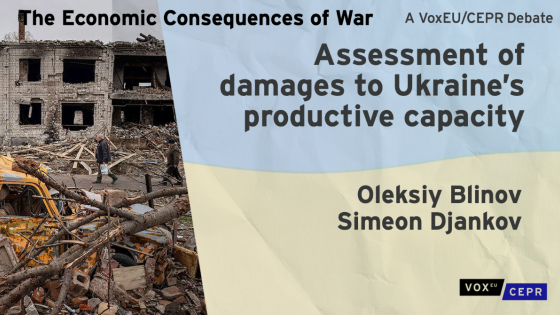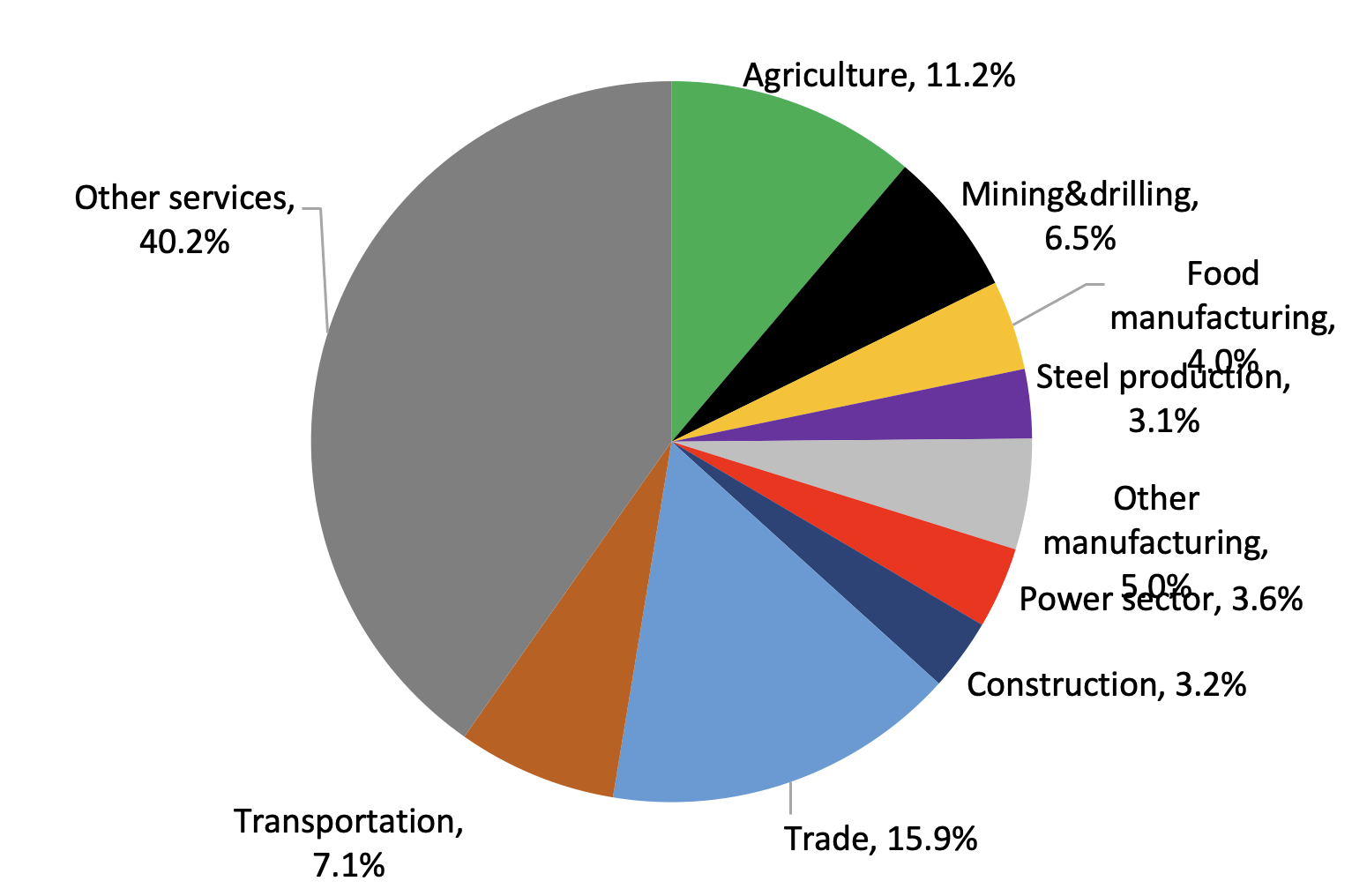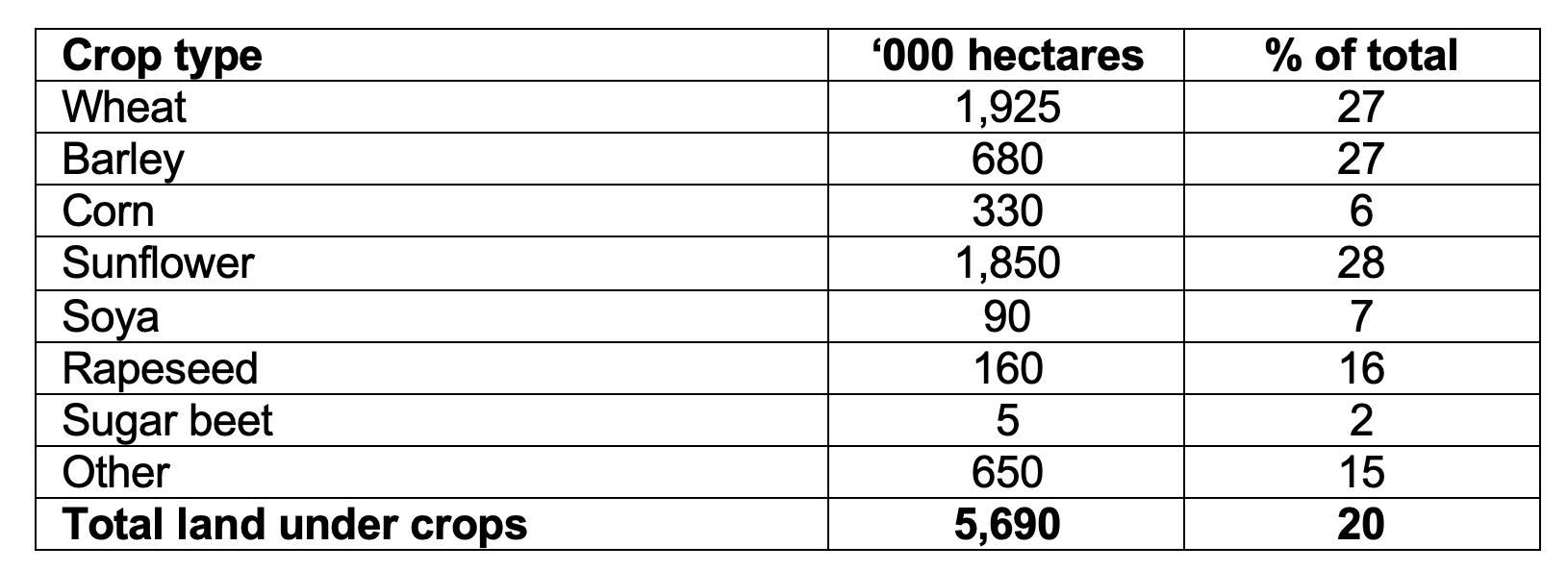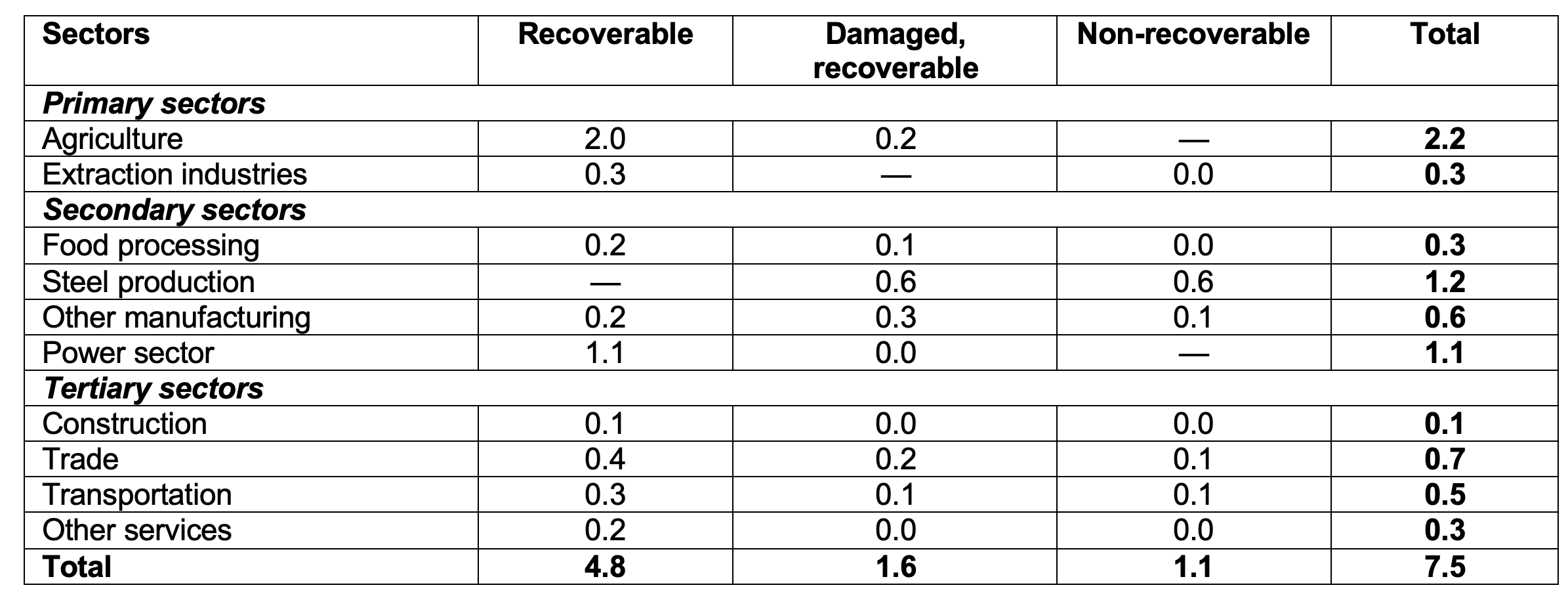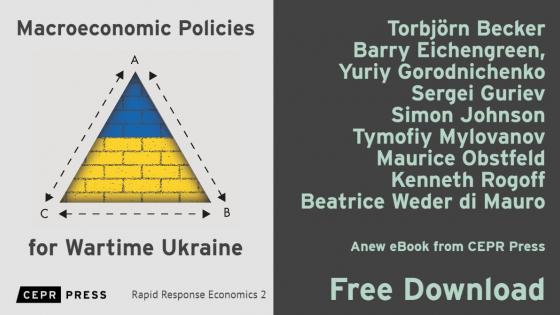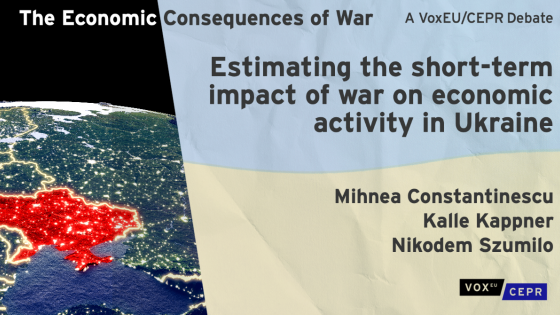Editors' note: This column is part of the Vox debate on the economic consequences of war.
There have been several attempts to estimate the damages to physical assets inflicted during the war in Ukraine (e.g. Skok 2022 and Tsyrennikov 2022). The best-known effort is the Russia Will Pay project, which employs micro-level analysis based on claims filed by Ukrainian households. As of 1 September 2022, this project has assessed $113.5 billion worth of physical infrastructure damages, corresponding to more than a half of Ukraine’s pre-war GDP. The biggest share of reported damages relates to apartment buildings ($48 billion) and transport infrastructure ($35 billion), with damages to corporate assets amounting to over $16 billion, including agricultural sector assets equivalent to $4.3 billion and energy sector assets worth $1.8 billion.
Extending this approach, a damage estimate was made by the Government of Ukraine in cooperation with international financial institutions under the Rapid Damage and Needs Assessment project (World Bank 2022). As of 1 June 2022, this project saw $97 billion in direct damage to physical infrastructure.
However, each measurement approach has its shortcomings. It is a challenge to assess the market value of productive assets during turmoil, especially those of privately held companies which constitute most businesses in Ukraine. For example, how should incurred revenue losses and temporary stoppages during the war be calculated? These would reduce the value of assets in a net present value calculation. Or, instead, can one apply a retrospective approach and use face value approximations?
In this column, we attempt a new approach to measuring the war toll on the Ukrainian corporate sector, excluding the service sectors, by assessing damage to productive capacity. This measurement accounts for irreversibly lost productive assets (destroyed or damaged beyond repair) and potentially recoverable ones (assets in regions occupied by Russian troops and/or damaged assets that can be repaired). Such an estimate should be instrumental for further re-assessments of Ukraine’s recovery path (Blinov and Djankov 2022a), based on actual developments in liberation of Ukraine’s territories and post-war reconstruction efforts.
An important caveat is that we assess only war-related asset damages that occurred between February 2022 and 1 September 2022. Such an assessment can also be applied to assets lost to hostile and unlawful seizure of Ukrainian territories in 2014 and 2015 too, but for the sake of a more streamlined application of this approach we limit ourselves to events since the start of 2022.
The post-war path of Ukraine has been the subject of previous VoxEU columns (most recently, Rogoff et al. 2022). Here, we contribute to this debate by providing a preliminary assessment for lost output incurring strictly from asset damages that needs to be taken into account when designing policies for the post-war economic recovery.
Estimation approach
Ukraine has been a rather concentrated economy, with a strong role of big enterprises in key manufacturing sectors. Thus, it is possible to establish much of the corporate assets’ damage on a sector-by-sector basis.
About two-thirds of national output in Ukraine is generated by services (Figure 1). Most of these services are a function of other industries. For instance, trade and transportation depend heavily on the export of primary (mining and agriculture) and secondary (manufacturing) sectors. Damages to these assets dampen the economic prospects of tertiary industries (services) as well, even if their assets are intact.
Figure 1 Ukraine’s pre-war GDP supply-side breakdown, average for 2019-21
Source: State Statistics Service of Ukraine, authors’ calculations.
Agriculture
Most physical asset damages in agriculture are related to land either occupied by the invading Russian forces or land that cannot be harvested because of land mines, nearby skirmishes, etc. We have compiled publicly available information on areas that fell under occupation in 2022 and have had military clashes that impeded agricultural activities such as spring seeding for spring crops and summer harvesting for winter crops, previously using this assessment to assess Ukraine’s harvest in 2022 (Blinov and Djankov 2022b).
The biggest land seizures in the agricultural sector have been seen in the south (Kherson and Zaporizhzhia) and east (Luhansk and Kharkiv) of Ukraine. These territories are more oriented towards winter crops and sunflower, bringing total national losses of land under wheat and barley to 27% and that under sunflower to 28% (Table 1). In contrast, most arable land for the production of corn is concentrated in the central and northern areas of the country, which either have not seen significant war activity or were liberated before the crop-seeding season.
The estimate of land that has been unavailable for agricultural production in 2022 is 20% of the total. Animal husbandry, a smaller part of Ukraine’s agricultural sector, is assumed to share the same distribution of losses.
Unlike other corporate assets whose damage is irreversible, land assets can be retrieved by successful military campaigns (prominent success was achieved in Kharkiv region after 1 September 2022). Still, the uncertainty of when such retrieval can take place and the length of bringing assets to productive use is the reason why we have included these damage estimates in our calculation.
Table 1 Land under key crops that became unavailable in 2022
Source: State Statistics Service of Ukraine, authors’ estimates.
There have also been grain silos, agricultural machinery, and other assets lost to shelling and rocket attacks, as well as to capture by the Russian army. These losses may not be critical to Ukraine’s short-term ability to stock its harvest, as temporarily storage capacity can be built expeditiously and at a small cost. But they would need to be replaced in the longer run, thus adding to the cost of war.
Also, as some of recovered lands would need clearance of land mines and thus may be deemed as ‘damaged’, we apply a 10% damage ratio to these assets, meaning 18% of agricultural output is easily recoverable, while another 2% needs damage compensation before being put into productive use.
Mining and drilling
This part of the Ukrainian economy consists of three major sectors. The first is iron ore mining, which accounts for about a half of total extraction industries output in Ukraine. These assets are concentrated in central Ukraine (around Kryvyi Rih and Kremenchuk) and have been uninterruptedly controlled by Ukraine, suffering only minor damage. However, one iron ore mining facility on the eastern bank of the river Dnipro, accounting for 7% of national output in 2021, has been occupied by invading forces.
Oil and gas extraction accounts for another 30% of national extraction industries output. As respective extraction capacities are concentrated in Poltava region and western part of the Kharkiv region, Ukraine maintains control over most of its oil and gas output. Production facilities on occupied territories may be estimated at 1% of total output. However, some territories occupied by Russia contain prospective fields, not developed yet.
While Ukraine’s Donbas region has been widely known for its vast coal industry, productive asset losses in 2022 have been rather contained there, too. As most of the productive capacity losses occurred in the period 2014-2015, it is the Dnipro region that has been providing the bulk (55%) of national coal output since then. In 2022, only 1% of national coal output capacity was directly seized by invading troops. However, the fighting in Eastern Ukraine has led to the flooding of some nearby mines which may result in a further 2-4% in irrevocable losses.
Overall, after aggregating the sectoral data, the assessment of temporarily unavailable assets in the mining and drilling sector comes at 4%, while irrevocably lost productive assets is another 1% on top of that.
Steel
The steel sector has suffered the largest productive capacity loss from the onset of the war. In Mariupol, the two big steel mills, Azovstal and Ilyich Steel Works, accounted for 20% of national crude steel output each before the 2022 war. Azovstal, which became a household name for Ukrainian armed resistance, was razed to ashes. The Ilyich Steel Works have been damaged significantly. Thus, according to a (simplified) crude steel measure, productive capacity is reduced by 40%, of which half is potentially recoverable when the region is reclaimed by Ukrainian forces, but with a heavy reconstruction bill.
Food manufacturing
In food manufacturing, war-related capacity losses have been limited. The sector is significantly diversified, which makes it hard both to inflict major losses on its operations and to assess war damage. The one exception is the big oilseed crushing facilities in the occupied cities of Vovchansk, Polohy, Kakhovka, Svatove, and Mariupol, with the latter reportedly severely damaged. We estimate temporary productive capacity losses in the food manufacturing sector to be at 7% of overall capacity (including 2% severely damaged) and the irrecoverable asset losses to be a further one percent.
Other manufacturing
Other manufacturing sectors are treated as one entity under this estimation. This group includes machine-building, production of construction materials, wood processing, textiles, coke and petroleum, and chemicals. The most prominent war-damaged productive assets are: (1) the Kremenchuk oil refinery, a petroleum producer severely damaged by multiple rocket attacks, (2) the Severodonetsk chemical plant, one of the biggest nitrogen fertilizer producers, occupied by invading forces, and (3) the Avdiivka coke plant, the biggest supplier of coke for the steel sector, severely damaged by artillery and shut down.
For this group, we estimate temporary productive capacity losses at 10% of total (including 6% in need of reconstruction), with three percent of irrecoverable asset losses on top of that.
Energy sector
The energy sector has been heavily impacted by the war. The total damage to the power grid and distribution equipment has yet to be compiled. However, several significant power plants have been occupied and/or damaged.
The most significant asset in question is Zaporizhzhia nuclear power plant, the biggest in Europe, accounting for almost half of national nuclear capacity, with the latter in turn providing 55% of Ukraine’s electrical power (Table 2). The fate of these assets would have many effects on the economy which fall beyond our estimation methods.
Table 2 Energy facilities damaged in the war
Source: Ministry for Energy of Ukraine, authors’ estimates.
Some 36% of intact energy sector assets are occupied. Furthermore, 7% of productive capacity has been assessed as damaged (this number includes 6% of capacity in occupied areas and 1% in Ukraine-controlled territories).
Tertiary sector spillovers and aggregation
After completing production function damage estimates for primary and secondary sectors, we proceed with tertiary sector spillover evaluation. For that task, we use input-output tables from Ukraine’s 2020 national accounts to define inter-sectoral dependencies for key service sectors (construction, trade, transportation, and others combined). Final modelling results, weighted by the role of sectors in the economy, are shown in Table 3.
Table 3 Contributions to production function loss in 2022 (in percentage points)
Source: Authors’ estimates.
Conclusions
Our sectoral model indicates that 7.5% of Ukraine’s productive capacity has been lost since the start of the Russian invasion in 2022. Much of this capacity can be retrieved once Ukraine reclaims its occupied regions. Heavy investment will be needed in the steel and perhaps energy sectors to regain pre-war capacity. Alternative types of production can be investigated as well, requiring less up-front capital.
This estimate for capacity losses should be treated as a complement to assessments of the nominal size of losses calculated by other analysts. While such projects concentrate on the ex-post loss estimation, our focus is on the ex-ante effect on output. The reader also has to bear in mind that some corporate assets have been operating at reduced capacity due to (1) domestic demand plunge, (2) public infrastructure disruptions, (3) corporate organisation shocks, (4) equipment losses, and (5) price and availability shocks for inputs. This reduced capacity use is on top of the reduction due to the physical damage to assets.
The limited scale of productive capacity losses warns against doomsday scenarios for the Ukrainian economy. With the recovery of occupied territories, the return of many refugees from abroad, and with the significant inflow of reconstruction financing, economic growth can return rather quickly.
References
Blinov, O and S Djankov (2022a), “Ukraine’s Recovery Challenge”, VoxEU.org, 31 May.
Blinov, O and S Djankov (2022b), “Restarting Ukraine’s Agricultural Exports”, VoxEU.org, 10 June.
Rogoff, K, B Weder di Mauro, T Mylovanov, M Obstfeld, S Johnson, S Guriev, Y Gorodnichenko, B Eichengreen and T Becker (2022), “Macroeconomic Policies for Wartime Ukraine”, VoxEU.org, 12 August.
Skok, Y (2022), “Will Ukraine’s economy survive the war?”, VoxEU.org, 25 March.
Tsyrennikov, V (2022), “A trillion-dollar question: What Russia owes Ukraine”, VoxEU.org, 6 April.
World Bank, Government of Ukraine and European Commission (2022), “Ukraine Rapid Damage and Needs Assessment”, August.
